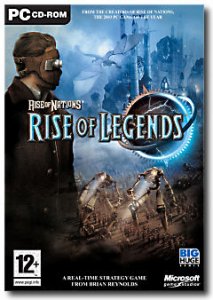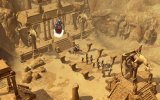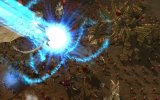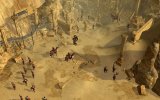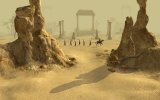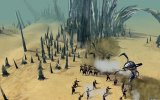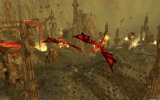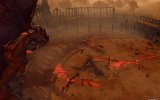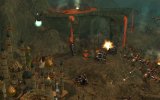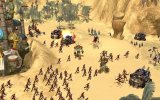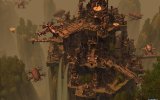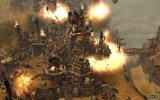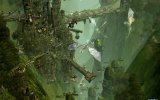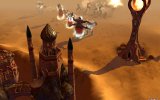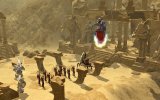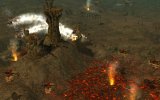Sorgono le Leggende
Ospite presso la sede di Microsoft alle porte di Milano, Brian non si è fatto pregare a illustrare le ragioni di questa scelta, ma per questo vi rimandiamo ai contenuti della prolissa e appassionante intervista.
Quanto vi servirà sapere, per ora, è che le fondamenta di Rise of Legends – ormai pressoché completo e in dirittura di arrivo sugli scaffali – saranno innanzitutto un’ambientazione fantasy e tre razze giocabili fortemente caratterizzate.
Piuttosto che su un banale setting fantasy rigurgitante elfi e goblin, la scelta di Brian è ricaduta su un mix di elementi fantastici forse meno delineati, ma particolarmente efficaci nel conferire personalità al gioco.
l’accostamento di tanti e tali dettagli inusuali costruisce un affresco ben diverso dall’ormai abusato high-fantasy tolkieniano
Sorgono le Leggende
La classica razza di partenza – gli “umani” insomma – è interpretata dai Vinci, una civiltà particolarmente avanzata, che in un modo pseudo-medievale hanno conosciuto un notevole progresso scientifico, sviluppando tecnologie dallo stile vicino allo steampunk e ai disegni – guarda caso – di Leonardo da Vinci.
Le loro città sono enormi agglomerati di silos metallici e ciminiere, costellati da gru meccaniche e ruote dentate e le loro unità condividono un design simile, come nel caso dei Clockwork Men, imponenti robot dai grossolani ingranaggi esposti.
A contrapporsi ai Vinci sono innanzitutto gli Alim, delle tre, la razza più vicina al concetto di “fantasy”, in quanto ispirata ai racconti de “Le Mille e una Notte”.
Aspettatevi quindi creature del mito ricche di magia come draghi, scorpioni giganti e malvagi geni, riunite in un esercito dall'inconfondibile impronta arabeggiante e pronte a solcare le dune del deserto per attaccare gli esseri umani.
Sorgono le Leggende
Chiudono la fila i Cuotl. Per lungo tempo tenuta segreta, la terza razza di Rise of Legenda è senza dubbio la più peculiare, ispirandosi ad alcune visioni del genere “fantascientifico-archeologico” secondo il quale alcune grandi civiltà del passato (Egizi, Inca, Maya…) sarebbero state avvicinate dagli alieni.
Nel particolare caso dei Cuotl, questi sono una potente razza aliena, precipitata a bordo di un’immensa arca spaziale in avaria. Bloccati su questo mondo, ma con ancora a disposizione una tecnologia così avanzata da sembrare magia, i Cuotl risolsero di conquistare il potere interpretando la parte di divinità per i nativi, in attesa di riuscire a contattare i propri simili.
Stilisticamente una commistione fra le grandi civiltà estinte sudamericane e gli antichi Egizi, le città dei Cuotl sono popolate da grandi zigurrath e generatori energetici fluttuanti, mentre le loro unità assomigliano a imponenti giganti di pietra.
Il vero aspetto degli alieni resta un mistero, ma molti dei loro “Eroi” (il cui ruolo, analogamente a WarCraft 3 e simili, è anche quello di interpretare la trama del gioco e di mettere in campo abilità speciali) sono riconoscibili dal particolare colosso/semidio robotico in cui si nascondono, interpretando i vari ruoli di divinità del Sole, delle Tempeste o della Morte.
Come potete vedere c’è abbastanza materiale da soddisfare le brame di qualunque appassionato di folklore fantastico e l’accostamento di tanti e tali dettagli inusuali costruisce un affresco ben diverso dall’ormai abusato high-fantasy tolkieniano.
Una robusta iniezione di esoterismo che si va quindi ad aggiungere a un robusto gameplay che ha ovviamente ricevuto la sua personale dose di aggiunte e rinnovamenti.
Ma non togliamo oltre la parola a Brian e vediamo di scendere finalmente nei dettagli in sua compagnia.
Faccia a faccia con Brian Reynolds
Multiplayer.it: Rise of Legend ha sorpreso molti di quanti si aspettavano un sequel più convenzionale. Perché avete deciso di ambientare il gioco in una ambientazione in stile fantasy?
Brian Reynolds: Rise of Nations era un gioco sulla storia dell’umanità dal più oscuro passato, fino all’età moderna.
Eravamo molto soddisfatti del gioco, ma volevamo provare qualcosa di nuovo, lasciar correre libera per un po’ la nostra fantasia… così abbiamo iniziato a pensare a diverse idee che avremmo potuto usare nel gioco successivo.
Allo stesso tempo ci rendemmo conto che avevamo ricevuto moltissimi complimenti per il gameplay di Rise of Nations, ma per quanto riguarda la grafica, la gente per lo più pensava che fosse “ok”.
A quel punto abbiamo pensato: ‘beh, possiamo fare un po’ meglio di “ok”!’ Abbiamo quindi deciso di mantenere un sacco delle idee di gameplay che avevamo sviluppato, ma costruimmo anche un motore grafico interamente nuovo. Allo scopo di mostrare tutti gli effetti e il tipo di grafica che potevamo raggiungere, iniziammo poi a realizzare tutte quelle idee in “stile fantasy”, per le quali eravamo piuttosto emozionati, essendo la nostra prima esperienza con il genere.
In questo modo avremmo potuto avere magie, enormi creature che camminano in giro… un’occasione per realizzare un mondo emozionante e immersivo. L’introduzione di un’ambientazione fantastica ha avuto anche questo come obiettivo.
Inoltre ci ha permesso di adattare i vari aspetti del gameplay e di evolverli lungo strade nuove e interessanti. Abbiamo sviluppato l’idea dei “confini”, abbiamo aggiunto “siti neutrali” che possono essere catturati, produrre unità speciali e attribuire particolari abilità.
Faccia a faccia con Brian Reynolds
Abbiamo mantenuto l’idea delle città che possono essere conquistate, ma abbiamo aggiunto il concetto di “distretto”, che le rende molto più personalizzabili nelle loro varie parti, mantenendo il loro aspetto imponendo e apparendo effettivamente come delle “città”.
Abbiamo anche conservato l’idea dei percorsi tecnologici, identificati attraverso colori, che possono essere personalizzati a seconda di cosa si voglia ricercare, assegnando a ciascuna razza un percorso completamente diverso e unico.
C’erano insomma parecchi elementi da sviluppare. Volevamo realizzare un gioco fantasy che non fosse semplicemente come ogni altro titolo del genere. Non ne volevamo uno con “orchi, elfi, nani e goblin”… il genere di cose già coperto in altri giochi.
Avevamo bisogno di creare un mondo nuovo, con alcune idee sufficientemente familiari da suscitare l’interesse dei giocatori. Ecco perché abbiamo creato le nostre nuove “nazioni”.
Multiplayer.it: Da quel che ho capito, è presente un'unica campagna in singolo, in cui col tempo si guadagnano alleati presso le altre razze. Questo significa che le altre due “nazioni” rappresentano per lo più i “cattivi” e che è possibile giocare esclusivamente con loro solo in multiplayer?
Brian Reynolds: In realtà la campagna single player è comunque suddivisa in tre capitoli.
Nel primo si giocano per lo più i Vinci. Nella seconda si giocano gli Alim e nella terza i Cuotl.
L’eroe principale - e alcuni dei suoi amici - attraversano l’intera storia, ma ad esempio, quando ci si reca nel deserto - a parte una manciata dei suoi compagni - tutti coloro che lo accompagneranno saranno i suoi alleati Alim. In pratica quindi, in quella parte della campagna si giocano gli Alim!
Multiplayer.it: Fino a che punto è possible “rubare” la tecnologia del nemico?
Brian Reynolds: In una partita multiplayer, ad esempio giocando gli Alim contro i Vinci, è possibile catturare alcuni siti o città nemiche e personalizzarle, magari aggiungendo distretti particolari.
Non è comunque normalmente possibile costruire le unità nemiche semplicemente impadronendosi dei loro edifici. L’unico modo per usare la tecnologia di altre razze è conquistando uno dei siti neutrali, come abbiamo visto nella dimostrazione, dove grazie a quell’edificio eravamo in grado di costruire l’unità volante dei Cuotl.
Qualunque razza avrebbe potuto conquistarlo e similarmente esistono alcuni siti magici da cui ottenere le unità degli Alim… quello che si trova dipende in genere dalla mappa in cui ti trovi, se una basata sulla giungla, il deserto, il ghiaccio e così via… dove potresti trovare accampamenti di barbari, strani artefatti, cittadine e villaggi.
A seconda di ciò che si trova si ottengono cose diverse, ma in ogni caso la maggior parte delle unità sotto il proprio controllo restano quelle della propria nazione.
Faccia a faccia con Brian Reynolds
Multiplayer.it: Un elemento piuttosto familiare negli RTS è il sistema di raccolta delle risorse. Come funziona in Rise of Legends e che differenze ci sono fra le varie razze?
Brian Reynolds: Rispetto a Rise of Nations, dove avevamo ben sei tipi di risorse diverse, abbiamo pensato che per un gioco fantasy avremmo dovuto usare un approccio più lineare.
Abbiamo mantenuto l’idea di un modello di risorse “infinito”, dove una volta che si raccolgono risorse da un luogo è possibile farlo senza che queste ultime si esauriscano.
C’è una sola risorsa principale, che abbiamo chiamato “Timonium”, una sorta di sostanza cristallina che si può trovare in giro per la mappa.
Tutti hanno bisogno di raccoglierlo, di individuare abbastanza luoghi per le proprie miniere e affrontare la concorrenza.
Gli Alim e i Vinci generano inoltre una seconda risorsa detta “benessere”, familiare ai giocatori di Rise of Nations, attraverso il commercio con le carovane fra le città.
E’ anche possibile commerciare con i siti neutrali, il che li renderà più amichevoli verso il giocatore e se lo si fa abbastanza a lungo è persino possibile assoldarli o fare in modo che si uniscano a te come alleati, il che significa che tutte le loro truppe entreranno a far parte del tuo esercito.
I Cuotl invece hanno bisogno di un’altra risorsa, detta “Energia”, creata per lo più dall’uso dei grossi reattori che costruiscono nei loro distretti.
Questa risorsa funziona in modo leggermente diverso ed è usata per motivi differenti.
Ad esempio i Cuotl devono pagare un costo in energia ogni volta che utilizzano i poteri dei loro eroi. Ci si ritrova quindi con questa razza tecnologicamente molto avanzata, ma che ha continuamente bisogno di trovare abbastanza energia per alimentarsi.
Queste sono le principali risorse, il cui accumulo è visibile nell’apposito riquadro dell’interfaccia, ma esistono altre risorse, per così dire, “nascoste”. Ad esempio tutti hanno bisogno di “punti ricerca” e li ottengono in modi diversi a seconda della nazione di appartenenza.
I Vinci annoverano inoltre i “Prototipi”, relativi a quando l’inventore si reca nell’apposito edificio e si mette a partorire ogni genere di strane e diverse unità speciali. Per questa ragione ottengono anche i cosidetti “Punti Prototipo”.
Multiplayer.it: Pensi che il gioco sia stato sviluppato con un approccio più orientato al single player o al multiplayer?
Brian Reynolds: Sicuramente entrambi. Per la parte multiplayer, abbiamo ora un sistema di generazione degli incontri completamente nuovo, che consente di connettersi e di ritrovarsi automaticamente abbinati con altri giocatori contro cui combattere. E’ anche possibile fare coppia con un amico e incontrare altre “squadre” in modo da dedicarsi alle partite in team.
Si possono creare partite personalizzate a piacere ed è effettivamente possibile riunire i propri amici per organizzarsi in clan.
Faccia a faccia con Brian Reynolds
E con il nostro sistema di supporto ai clan, non solo è possibile chattare e inviare messaggi, ma stiliamo statistiche sui diversi clan, sulla quantità di partite vinte o perse, la razza in cui si è più bravi a giocare e così via, in modo da potersi confrontare con i membri di altri clan o scalare la ladder individuale.
Insomma, moltissimo materiale anche sul fronte online.
Per la parte single player, abbiamo conservato il taglio della campagna di Rise of Nations – l’abbiamo chiamata “Conquista il Mondo” - una campagna realmente aperta, ambientata in una mappa di grande scala, che abbiamo sviluppato e cui abbiamo aggiunto alcune nuove feature.
Multiplayer.it: Perchè avete deciso di includere meno razze del precedente gioco?
Brian Reynolds: Sembrava la cosa più appropriata in relazione all’ambientazione fantasy.
Quando abbiamo realizzato Rise of Nations – che trattava la Storia dell’umanità – abbiamo voluto includere un sacco di differenti nazioni, ma le differenze fra di esse erano piuttosto ridotte, visto che nei giochi “storici”, tutti hanno un soldato con arco e frecce, tutti ne hanno uno con la lancia e uno a cavallo e così via.
Le differenze c’erano, ma non erano pronunciate, mentre per un titolo fantasy, la cosa migliore ci parve proprio quella di avere, prima di ogni altra cosa, meno razze su cui concentrarsi, in modo da mostrare quanto potessero essere interessanti nelle loro differenze.
Ora ognuna delle razze è completamente unica, con ciascuna unità completamente differente da ogni altra e lo stesso vale per gli eroi, gli edifici, le tecnologie.
Il nostro obiettivo era proprio quello di introdurre elementi ben distinti fra loro e penso che questo fosse compatibile e necessario per farlo “sentire” come un gioco fantasy. Lo fa apparire più “focalizzato”, in grado di attirare l’attenzione delle persone.
Dubito che avrei potuto “spiegare” al pubblico 18 diverse nazioni in un gioco fantasy, ma sapevo che avremmo potuto fare un ottimo lavoro “spiegandone” tre e rendendole ricche e interessanti.
Multiplayer.it: Quale credi che sia la caratteristica più attraente del gioco?
Brian Reynolds: Difficile dirlo, piuttosto che creare un gioco attorno a una specifica caratteristica, quello che volevamo fare era creare questa esperienza globale e immersiva, dove non ci fosse soltanto l’ottimo gameplay di Rise of Nation, ma anche un intero nuovo set di tecnologie, di effetti grafici e, ovviamente, questo nuovo mondo fantasy che il pubblico non aveva ancora mai visto. Se ai giocatori piacerà Rise of Legends, sarà perché avranno amato il mondo che abbiamo creato, lo avranno percepito come un luogo divertente dove andare a vivere avventure. Se quindi il mondo saprà essere attraente, allora il gioco sarà un successo.
Ringraziamo Brian, Big Huge Games e Microsoft Italia per la disponibilità.
Face to face with Brian Reynolds
Multiplayer.it: Rise of Legends surprised many people, who expected a more conventional sequel. What made you decide to place the game in a medieval, fantasy-like, setting?
Brian Reynolds: Well, Rise of Nations was a game that took the history of mankind from the dark times to the modern era.
We were very excited by that game, but we wanted do something new, let our imagination run wild a little bit and we started thinking about different ideas we could have used for the next game. At the same we realized that we’ve been praised a lot for Rise of Nations for the innovative gameplay, while for the people, the graphic was “ok”.
And then we thout: well, we can do a little better than “ok”.
So we decided to keep a lot of the gameplay ideas that we developed, but we built a completely new engine and in order to show off the graphics we could do, we also started making the “fantasy game ideas”, which were also exciting to us because we are new to the genre. And then we would have big spells, huge creatures walking around… a chance to make a really amazing and immersive world. [Introducing] the fantasy world had also that goal.
Then we were able to adapt the gameplay features and bring them forward to be new and interesting in a different way.
So we brought forward the “national borders”, we added “neutral sites” that can be captured and produce special units and give you special abilities.
We kept the idea of cities that can be captured, but we added the idea of “districts”, which makes the cities customizable with different parts, still looking very big and really like “cities” now. We kept the idea of the color-coded technology tracking that you can customize with things you want to research, but we gave every race a completely different and unique technology track. Those were some of the things that we went forward. We wanted to make a fantasy game that wasn’t just like any other fantasy game. We didn’t want to do orcs and elves and dwarves and goblins… That is sort of covered by other games.
So we needed to create a new kind of world with some new ideas that at the same time were familiar enough, so the players would be excited about them.
That’s how we created our new nations.
Multiplayer.it: As far as I understand, there is only one singleplayer campaign, while you can get allies from the other races. Are the other two races mainly the “bad guys” and is it possible to play just them only in the multiplayer mode?
Brian Reynolds: The campaign is actually a series of three chapters. In the first chapter you mostly play Vinci. In the second chapter you mostly play the Alim and in the third chapter the Cuotl. You do have your hero - and some of his friends - that go through the whole story, but you’ll find yourself that, for example, when he goes to the desert, aside from a couple of characters, all those with him are actually his Alim allies. So you’re basically playing the Alim in the campaign, for that part.
Multiplayer.it: To which extent is possible to steal enemy technology?
Brian Reynolds: For example in a multiplayer game, if you’re playing the Alim against, maybe, the Vinci, you can take over some of their sites, like cities, and build more of their districts.
Still, you can’t normally get units from the other nations just by taking over their buildings. The only way you can get technology from a different nation is from some of the neutral sites, like we saw in the demonstration, where we took over that building that allowed us to build the Cuotl air units. Anybody could have taken over that building, whether the Vinci or the Alim. Similarly there are certain magical places where you can get the Alim units… partly it depends on which map you are on, a jungle map, an ice or desert one, or wherever. That will make a difference about whether you find barbarian camps or strange artefacts or towns and villages…
Depending on what you find, you will get those things, but most of your units will belong to the nation you started with anyway.
Multiplayer.it: A very familiar thing with RTS games is resource collecting. How are the differences between the different races?
Brian Reynolds: Compared to Rise of Nations, where we had like six different resources, we felt like that in a fantasy game we wanted a more streamline approach. We kept the idea from Rise of Nations of a sort of “infinite resource model”, where once you’re collecting from somewhere, you can always collect from there and the resources never ran out.
There is one main resource that we called “Timonium”, that is sort of a crystal substance you find around the map. Everybody needs to mine that and find enough places to build your mines and confront with whoever is fighting over that.
The Alim and Vinci create a second resource called “wealth” through trading with caravans between cities, which will be familiar to Rise of Nations players.
You can also trade with neutral locations. This will make them more friendly to you and if you do that enough, then you might be able to bribe them or join you as allies, which means all the troops that they have will actually come and join your army.
On the other hand, the Cuotl have a different resource called “Energy” and they create it mostly by building these big reactors in their districts. That resource actually works a little differently, it’s used for slightly different things. For example the Cuotl have to pay every time they want to use one of their hero abilities. So there is sort of this alien race with very high technology, but they have to find enough energy to power all the time, there is the challenge.
Those are the main resources that you actually collect in a big bucket in the top of the screen, but we have other sorts of “hidden” resources. For example every nation gets “research points” and they collect them in a different way depending on which nation they are.
The Vinci also have another kind of thing called “Prototypes”, which is when the inventor goes into a building and creates all kinds of different, weird, special units.
So, the Vinci can get “Prototypes Points” and use them to create this kind of units as well.
Multiplayer.it: Do you think the game is been designed primarily around the singleplayer or the multiplayer gameplay?
Brian Reynolds: Definitely both actually. For the multiplayer side, we got a whole new match-making service, which allows you to go online and be automatically matched up with other players to play against, or you can go on with a friend and match up along with him to play a team game online.
You can make custom games whenever you want and then you can actually take your friends and form what it’s called a clan.
With our clan support we not only allow to chat with the other members and send messages, we also actually track statistics about your clan, about how many games you won and lost, which nations you’re good at playing, so you can be able to compare yourself to the members of other clans, as well as moving up to the individual ladder.
So, lots of stuff in the multiplayer side. For the singleplayer side, we took the campaign that players liked in Rise of Nations - we called it “Conquer the World” – which is a very open-ending strategic campaign on a big scale map.
We brought that forward, added some new features and so, we have again this open-ending strategic campaign for the solo side.... A lot of work there as well.
Multiplayer.it: Why did you decide to go with fewer races this time?
Brian Reynolds: It seemed appropriate to the fantasy topic. When we were doing Rise of Nations – a game about the history of mankind – we wanted to have a lot of different nations, but they were “all that” different from each other, because in history games, everybody has, of course, a bow and arrow guy, everybody has a spear guy, everybody has a horse, or needs a tank and so on. There were some differences between those, but they weren’t big differences, while for a fantasy game, the thing that seemed more cool was, first of all, to have few races to concentrate on, showing how interesting and different they are. So each of the races is completely unique, with any unit completely different to whatever other unit, every technology, building and hero.
We really had the goal to make each thing completely separate, different and unique and we think that goes in line to make it feel like a fantasy game. It makes it feel more focused, so that we can get people interested in.
I don’t think I could “explain” 18 different nations to people in a fantasy game, but we can do a really good job explaining three and have them very rich and interesting.
Multiplayer.it: What do you think is the most compelling feature of the game?
Brian Reynolds: Oh, that’s hard, because what we’ve really been trying to do is not to create a game about one specific feature, but create this overall, immersive experience where we don’t just have the great gameplay from Rise of Nations, but we also have a completely new set of technologies, graphics, spells and effects and this new fantasy world that people haven’t seen before.
If players will like Rise of Legends, it’s going to be because they will be excited about the world, they’ll feel this is a place that’s fun to go. So, if the world is compelling, then [the game] will be a success.
We'd like to thank Brian, Big Huge Games and e Microsoft Italia for their courtesy.
Ecco una piccola anteprima della nostra intervista a Brian Reynolds. In Area Files, in esclusiva per gli abbonati Gold, è disponibile invece l'intero filmato, in alta risoluzione.
Link per il download [VIDEO=320.300.c.s]https://multiplayer.it/streaming/BrianReynolds_BigHugeGames_EsclusivaMultiplayer.it_estratto.wmv[/VIDEO]
Sorgono le Leggende
Brillante mente dedita al game design (nonché fautore di autentici capolavori quali Civilization 2, Colonization e Alpha Centauri) Brian Reynolds ha ricevuto diversi riconoscimenti negli ultimi anni, tanto per il contributo dato al mondo dei videogiochi che per il successo riscosso dal primo gioco di Big Huge Games, lo studio da lui stesso creato dopo aver lasciato Firaxis.
Additato tanto dalla critica che dal pubblico come una perla di giocabilità e originalità, Rise of Nations è stato per diverso tempo il “nome nuovo” della scena RTS e tutto lasciava intendere che presto o tardi un seguito avrebbe visto la luce.
Ciò che forse nessuno si immaginava è stata la rivelazione che Rise of Legends, piuttosto che un nuovo strategico “storico” alla Age of Empires, avrebbe strizzato l’occhio a Blizzard, al suo WarCraft e quindi al filone degli strategici fantasy da lui inaugurato e di cui è ancora per molti versi la massima espressione.


